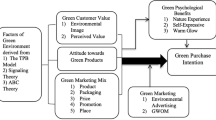Abstract
The shopping trip to the grocery store is one of the most basic elements of consumer behavior. The authors seek to provide an understanding of the factors that account for variations in shopping behavior across households. They present a model of shopping behavior that assumes that households seek to minimize the travel cost associated with shopping and the cost of holding goods in inventory. As in the classic EOQ model, observed shopping behavior reflects the manner in which households balance these costs while meeting their consumption needs. A number of propositions derived from the model are tested using data on shopping trips made by households over a one-year period. The results support the model and indicate that the relationship between household characteristics and shopping behavior can be fairly complex: for some households shopping may have a recreational aspect while for others it may compete directly with wage-earning activity.
Similar content being viewed by others
References
Assunçao, Joao and Robert J. Meyer. (1993). “The Rational Effect of Price Promotions on Sales and Consumption,” Management Science 39, 517–535.
Bacon, R. (1984). Consumer Spatial Behavior. New York: Oxford University Press.
Becker, Gary S. (1965). “A Theory of Allocation of Time,” Economic Journal 75, 493–517.
Benus, J., J. Kmenta and H.T. Shapiro. (1976). “The Dynamics of Household Budget Allocation of Food Expenditures,” The Review of Economics and Statistics 58, 129–37.
Blattberg, R.C., T. Buesing, P. Peacock and S. Sen. (1978). “Identifying the Deal Prone Segment,” Journal of Marketing Research 15, 369–77.
Fareed, A.E. and G.D. Riggs. (1982). “Old-Young Differences in Consumer Expenditure Patterns,” Journal of Consumer Affairs 16(1), 152–159.
Ghosh, A. and S. McLafferty. (1984). “A Model of Consumer Propensity for Multipurpose Shopping.” Geographical Analysis 16, 244–49.
Ghosh, A. and S. McLafferty. (1987). Location Strategies for Retail and Service Firms. Lexington, MA: D. C. Heath.
Goldman, A., and J.K. Johansson. (1978). “Determinants of Search for Lower Prices: An Empirical Asesssment of the Economics of Information Theory,” Journal of Consumer Research 5, 176–86.
Hanson, S. (1980). “Spatial Diversification and Multipurpose Travel: Implications for Choice Theory,” Geographical Analysis 12, 245–57.
Houthakker, H.S., and L.D. Taylor. (1970). Consumer Demand in the United States 1929–1970, Analysis and Projections. Cambridge, Mass.: Harvard University Press.
Hubbard, R. (1978). “A Review of Selected Factors Conditioning Consumer Travel Behavior,” Journal of Consumer Research 5, 7–21.
Ingene, Charles A. and Avijit Ghosh. (1990). “Consumer and Producer Behavior in a Multipurpose Shopping Environment,” Geographical Analysis 22, 70–93.
Kahn, B.E., and D.C. Schmittlein. (1989). “Shopping Trip Behavior: An Empirical Investigation,” Marketing Letters 1, 55–70.
Lee, Jong-Y, and M.G. Brown. (1986). “Food Expenditures at Home and Away from Home in the United States—A Switching Regression Analysis,” The Review of Economics and Statistics 68, 142–47.
McClements, L.D. (1977). “Equivalent Scales for Children,” Journal of Public Economics 8, 191–210.
Muelbauer, J. (1980). “The Estimation of Prais-Houthakker Model of Equivalence Scales,” Econometrica 48, 153–76.
O'Kelly, M. (1981). “A Model of the Demand for Retail Facilities Incorporating Multistop, Multipurpose Trips,” Geographical Analysis 13, 134–48.
Pindyck, Robert S. and Daniel L. Rubinfeld. (1981). Economic Models and Economic Forecasts. New York: McGraw-Hill.
Prais, S.J., and H.S. Houthakker. (1971). The Analysis of Family Budgets. Cambridge, England: Cambridge University Press.
Author information
Authors and Affiliations
Rights and permissions
About this article
Cite this article
Bawa, K., Ghosh, A. A Model of Household Grocery Shopping Behavior. Marketing Letters 10, 149–160 (1999). https://doi.org/10.1023/A:1008093014534
Issue Date:
DOI: https://doi.org/10.1023/A:1008093014534




